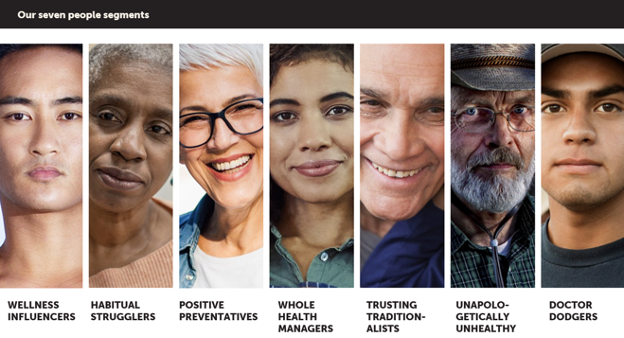Humanizing Care Communications and Experience: Curtail distrust with personalization

Adapted from our “Humanizing content: Leveraging segmentation to deliver personalized communications” webinar
Gone are the days when patients deferred near-total agency to the authority of healthcare professionals. Today, people are even taking matters into their own hands in a variety of ways, blazing new, unique (perhaps, risky) paths to health and wellness.
Reputability and trustworthiness of a healthcare provider no longer rest on consistency and expertise alone; in this rapidly changing market, health organizations need to stay nimble and more adaptive than ever to increase engagement and gain back trust.
Data from Monigle’s 2024 Humanizing Brand Experience study identifies three areas of focus for organizations as this brave new world rapidly closes in, the first of these being, personalization.
A one-size-fits all communications approach is failing
Our research has shown that providers quick to medicate symptoms instead of finding their root cause are negatively appraised by patients, detracting from their trust in providers and perceptions that they have their patients’ best interests at heart. This has been cited as reason enough for a patient to move on to a new primary care provider, or worse, to delay care or opt out altogether. More than ever, patients come to appointments well-researched, with their own hypotheses, already having attempted at-home treatments, and more likely to deny a diagnosis if it doesn’t feel right (“I know my body,” I often hear in focus groups).
Distrust (“I don’t always trust my healthcare provider to make the right decisions for me”) is becoming a real problem, we’re seeing an upward trend there year over year; and, this year, more than one third of consumers ages 25-55 agree with this statement.
With distrust on the rise and technology-enabled philosophies of self-reliance, consumers are seeking dialogue and deliberation when it comes to their health, not dogma; they want to be heard as much as they want to listen, to be taken seriously, and be the final decision makers in treatment plans. Patients don’t want a healthcare provider; they want a healthcare partner.
This is also evident in the top emerging brand attributes correlated with HCAHPS—Wellness, Personalization, Empathy, Coordination, Buzz and Transparency – that exhibited major shifts in rank compared to previous years, and, together, map back to this pattern of partnership. In 2023, Wellness (#2) and Personalization (#3) even outrank Quality Outcomes (#5) for the first time!

Peoples’ relationships with healthcare are changing dramatically; and they know that the healthcare that’s best for them comes tailor-made. Not only that, but they’re sensitive to signals that insinuate a partnership approach when choosing where to go for their healthcare.
So, how do you respond? It’s simple, find a way to meet consumers where they are by (1) getting to know the human behind the patient, (2) addressing their unique personas, and (3) delivering a personalized health, care and wellness experience.
Understanding the human behind the patient
Before personalization is possible, the first step, naturally, is to segment the total market by leveraging advanced analytics and clustering methods to group people based on their unique attitudes to health, care and wellness. In fact, people’s challenges and concerns are 60% more likely to be understood by companies that segment their customers. You can opt in for a custom segmentation, or a tried and tested existing segmentation.
At Monigle we’ve already developed a segmentation in healthcare that has been validated and based on over 25,000 interviews with U.S. consumers. Built upon strict brand and research principles, it offers a validated panorama of the American healthcare consumer landscape. Grant Mason, the Head of Monigle’s Behavioral Insights Group, goes in-depth about our model, its fundamental principles, and the human segments here.

Activating segmentation by fusing to internal datasets
Another secret super-power of having segments on hand is the ability to empower your organization to deliver more personalized content and experiences that yield real outcomes by adapting tactics to the varying nuances within your audience.
Virtua Health had tremendous success when they adjusted existing content strategies according to insights from our national healthcare consumer segmentation. After applying Monigle’s proprietary Humanizing Brand Experience segmentation algorithm to over a million patients in their CRM they successfully optimized their content by targeting each segment with personalized messaging.
The results: Virtua Health doubled their campaign’s conversion rates. Doubled. And saw a 13% increase in open rate. In fact, all their KPIs tested higher with Monigle’s attitudinal segments than without.
There are two ways to activate our segmentation in your market:
- Primary data: add our typing tool to a custom survey, such as your brand tracking survey
- Bridging model: add a ‘look-alike’ segmentation to your CRM; this isn’t as accurate as the typing tool, but you can scale it quickly and connect it to existing datasets without the hassle of having people take a survey to classify them into a segment.
Depending on your internal resources and ability to survey existing patients, one method may be more advantageous over the other. We can consult with you to ensure you make the right choice for your organization.
Personalizing content to drive real outcomes
Once equipped with a discerning segmentation tool, your next objective is to socialize the framework, so your entire organization is empowered to connect and engage with your customers on a human level.
This is how Virtua Health successfully appealed to different segments and communicated their commitment. Through a collective effort and various iterations of tactics and campaign guidelines that synthesized their brand strategy with all the newfound segment data at hand, they demonstratively hit their targets to personalize outreach, improve targeting, enhance engagement, and, ultimately, amplify trust.
The results, as mentioned, were staggering. What’s especially interesting is that, beyond those awesome KPI shifts, the results of the personalized campaigns also validated our informed hypothesis that personalization is a tactical solution to the changed consumer market landscape; if you recall, we’re seeing a growing need in consumers for control over their own health coinciding with growing distrust of providers.
One of these validating findings was that these personalized campaigns had a significant impact on trust. The Whole-Health Managers’, one of the fastest growing segments, perception of “safety of inpatient care” saw a lift of 24%. Even the Trusting Traditionalist got even more trusting, with a 7% lift in perception of safety after the campaigns.
A key thing to note here is that brands should still build their brand platforms based on a total market view, no one is advocating for anything besides. However, intimate knowledge of a segmented consumer market can give you the capability to translate your platform with bespoke activations and tactics, be it marketing or customer experience.
Segmentation is effective mass marketing
To segment, or not to segment?
Like all worthwhile debates, the truth is in the depth of nuance. But the prosecution stands on a generalized view, they say: branding based on only part of your potential market is a death wish. Then, practically in the same breath, say something like, sophisticated mass marketing means don’t exclude.
Well, ladies and gentlemen of the jury, I ask you, how does a brand even avoid exclusions in their mass marketing if it only collects data in vast averages?
Intimate knowledge of your segmented consumer market isn’t about positioning your whole brand platform, it’s about sharpening your tactics and creating bespoke activations; without which, you’d be chasing profits with a blunt tool.
In light of emerging themes in consumer behavior and perceptions in healthcare, showing individuals trending evermore towards self-reliance and distrust, healthcare organizations can differentiate themselves by finding ways to make people feel seen and give them a place where they can partner with a provider to ensure their unique needs are met.
Want to keep the conversation going? Email us at insights@monigle.com

